Durst F. Fluid Mechanics: An Introduction to the Theory of Fluid Flows
Подождите немного. Документ загружается.


634 20 Fluid Flows with Heat Transfer
predefined and did not enter into the fluid-mechanical considerations of the
quantities of the flow problem as unknowns that were to be computed. Thus
the complexity of flow-problem solutions was considerably reduced, as with
constant values for ρ, µ and λ the strong coupling between the momentum
equations and the energy equation was broken. For the solution of flow prob-
lems, it was therefore sufficient to solve the continuity and the momentum
equations, i.e. the energy equation had only to be employed when, in addition
to the knowledge of the flow field, information on the temperature field of
the fluid was needed.
In this section, a flow problem will be considered for which it is no longer
permissible to neglect the density modifications that occur. Restrictively, it
will be assumed, however, that only small density modifications arise, so that
the following holds:
ρ = ρ
0
+ ∆ρ ≈ ρ
0
[1 − β
0
(T − T
0
)] with β
0
= −
1
ρ
0
∂ρ
∂T
p
. (20.36)
With this, the equations of fluid mechanics can be stated as follows:
∂U
i
∂x
i
=0, (20.37)
ρ
0
∂U
j
∂t
+ U
i
∂U
j
∂x
i
= −
∂
∂x
j
(P − ρ
0
g
j
x
j
)+µ
∂
2
U
j
∂x
i
2
+(ρ − ρ
0
) g
j
, (20.38)
(ρ − ρ
0
)=−ρ
0
β
0
(T − T
0
), (20.39)
∂T
∂t
+ U
i
∂T
∂x
i
=
λ
0
ρ
0
c
p0
∂
2
T
∂x
i
2
. (20.40)
These equations can be employed for examining flows driven by density
differences, i.e. with the above set of partial differential equations natural
convection flows can be described mathematically.
From these equations, one obtains for two-dimensional flow conditions
∂/∂x
3
(...) = 0, and for fully developed flows ∂/∂x
2
(U
j
) = 0, the following
simplified equations:
• Momentum equation:
ρ
∂U
2
∂t
= −
∂Π
∂x
2
+ ρgβ
0
(T − T
0
)+µ
∂
2
U
2
∂x
1
2
. (20.41)
• Energy equation:
ρc
p
∂T
∂t
= λ
∂
2
T
∂x
1
2
+ µ
dU
2
dx
1
2
(20.42)
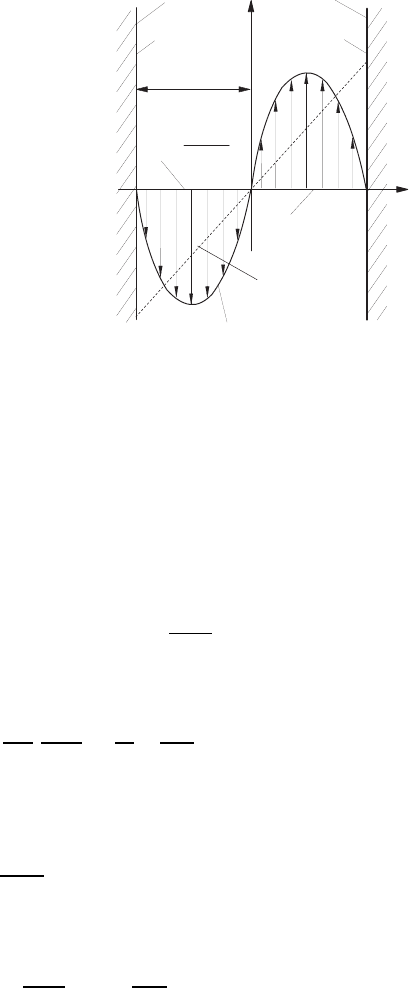
20.3 Natural Convection Flow 635
Fig. 20.5 Free convective flow between
vertical plates
+
D
Wall
Wall
Upwards
directed flow
Downwards
directed flow
x
1
x
2
T
N
T
H
T =
M
T
H
T
N
2
+
T(x
)
1
where, concerning the axial directions, the coordinate system stated in
Fig. 20.5 was chosen.
Equations (20.41) and (20.42) can now be simplified for stationary
flows, that run without an external pressure gradient, i.e. ∂Π/∂x
2
=0.
For such flows, the basic equations describing natural convection hold as
follows:
• Momentum equation:
0=ρgβ
0
(T − T
0
)+µ
d
2
U
2
dx
1
2
. (20.43)
• Energy equation:
0=
λ
ρc
p
d
2
T
dx
1
2
+
ν
c
p
dU
2
dx
1
2
. (20.44)
For the flow driven by natural convection between two plates, the momentum
equation results in the following form:
0=µ
d
2
U
2
dx
1
2
+ ρ
M
gβ
M
(T − T
M
) (20.45)
and the energy equation, taking into consideration the above assumption,
can be written as:
0=λ
d
2
T
dx
1
2
+ µ
dU
2
dx
1
2
, (20.46)
where T
M
=1/2(T
H
+ T
N
). The subsequent boundary conditions describe
the natural convection flow problem sketched in Fig. 20.5:

636 20 Fluid Flows with Heat Transfer
U
2
(D)=U
2
(−D)=0, (20.47)
T (D)=T
H
; T (−D)=T
N
. (20.48)
Introducing the so-called buoyancy-viscosity parameter A:
A =
β
M
gµD
λ
(20.49)
the basic equations can be normalized as stated below, introducing the
following dimensionless quantities:
x
∗
1
= x
1
/D; U
∗
2
=
ρDU
2
µ
; T
∗
=
(T − T
N
)
(T
H
− T
N
)
. (20.50)
One obtains in this way the following dimensionless equations for the
resultant velocity and temperature distribution:
d
2
U
∗
2
dx
∗
1
2
= −GrT
∗
and
d
2
T
∗
dx
∗
1
2
= −
A
Gr
, (20.51)
where the Grashof number Gr results from the derivations as follows:
Gr =
gρ
2
D
3
β (T
H
− T
N
)
µ
2
. (20.52)
When considering that the buoyancy-viscosity parameter A assumes very
small values for most fluids and that moreover Gr assumes large values
for buoyancy-driven flows, relevant in practice, then for the dimensionless
temperature distribution, the following is obtained to a good approximation:
d
2
T
∗
dx
∗
1
2
=0 ; T
∗
= C
1
x
∗
1
+ C
2
. (20.53)
With T
∗
= −1forx
∗
1
= −1andT
∗
=1forx
∗
1
= 1 one obtains C
1
=1and
C
2
=0andthus
T
∗
= x
∗
1
(20.54)
T
∗
inserted in (20.51) yields
d
2
U
∗
2
dx
∗
1
2
= −Grx
∗
1
and hence U
∗
2
= −
Gr
6
x
∗3
1
+ C
1
x
∗
1
+ C
2
. (20.55)
With the boundary conditions at x
∗
1
=1:U
∗
2
=0andatx
∗
1
= −1: U
∗
2
=0,
one obtains C
1
= Gr/6andC
2
=0andthus
U
∗
2
=
Gr
6
!
x
∗
1
− x
∗3
1
"
. (20.56)
The resulting temperature distribution emerges from this analysis as linear. It
thus represents the distribution typical for pure heat conduction. On the other
hand, the velocity distribution is described by a point-symmetrical cubic
function as sketched in Fig. 20.5. Along the wall with the higher temperature,
an upward directed flow forms, and on the side of the cool wall a flow forms
that is directed downwards. Flows of this kind can occur between the planes
of insulating-glass windows when these have been dimensioned incorrectly.

20.4 Non-Stationary Free Convection Flow 637
20.4 Non-Stationary Free Convection Flow Near
a Plane Vertical Plate
The combined flow and heat-transfer problem discussed in this section, deals
with the diffusion of heat from a vertical wall, heated suddenly and brought
to a temperature T
W
at time t = 0. The diffusion of heat takes place into an
infinitely extended field extending into a half-plane. The density modifications
in the fluid, caused by the heat diffusion, result in buoyancy forces, and these
in turn lead to a fluid movement that can be treated analytically as a free
convection flow. With it the basic equations, expanded in the momentum
equations by the Oberbeck/Bussinesq terms as stated in Sect. 20.3, can be
given as indicated below in the form of a system of one-dimensional equations.
Basically equations result for an unsteady flow providing a basis for the sought
solution. In this context the following was taken into consideration:
• Because of ∂U
2
/∂x
2
= 0, due to the fully developed flow in the x
2
direction,
one obtains from the two-dimensional continuity equation U
1
= constant.
As U
1
= 0 at the wall is given, one obtains U
1
= 0 in the entire flow area.
• With the above insights, the left-hand side of the x
2
momentum equation
reduces to the term ρ
0
(∂U
2
/∂t), so that the following system of equations
holds for the considered natural convective flow problem:
– Momentum equation:
ρ
0
∂U
2
∂t
= µ
0
∂
2
U
2
∂x
1
2
+(ρ − ρ
0
)g. (20.57)
– Energy equation:
ρ
0
c
p,0
∂T
∂t
= λ
0
∂
2
T
∂x
1
2
. (20.58)
The dissipation term in the energy equation µ (dU
2
/dx
1
)
2
was neglected here
for reasons stated in Sect. 20.3. For further details, see also ref. [20.4].
For the further explanation of the problem to be examined here, it should
be said that for all times t<0 the following holds: U
2
(x
1
,t)=0and
T (x
1
,t)=T
0
for x
1
≥ 0, i.e. in the entire area filled with fluid there is
initially no flow, and the fluid has the same temperature everywhere.
For all times t ≥ 0, the following boundary conditions will hold: U
2
(0,t)=0
(no-slip condition at the wall) and T (0,t)=T
W
(sudden increase of the wall
temperature). Moreover, the flow problem to be examined is described for
x
1
→∞by U
2
(∞,t)=0andT (∞,t)=T
0
.
The velocity and temperature fields sketched in Fig. 20.6 indicate the dif-
fusion processes that take place and how they contribute to the initiation of
the described buoyancy flow. The molecular diffusion of the temperature field
is evident, together with the induced fluid movement and the momentum loss
to the wall. Important for the quantitative information to be derived here is
the presence of an analytical solution of the buoyancy problem indicated in
Fig. 20.6.
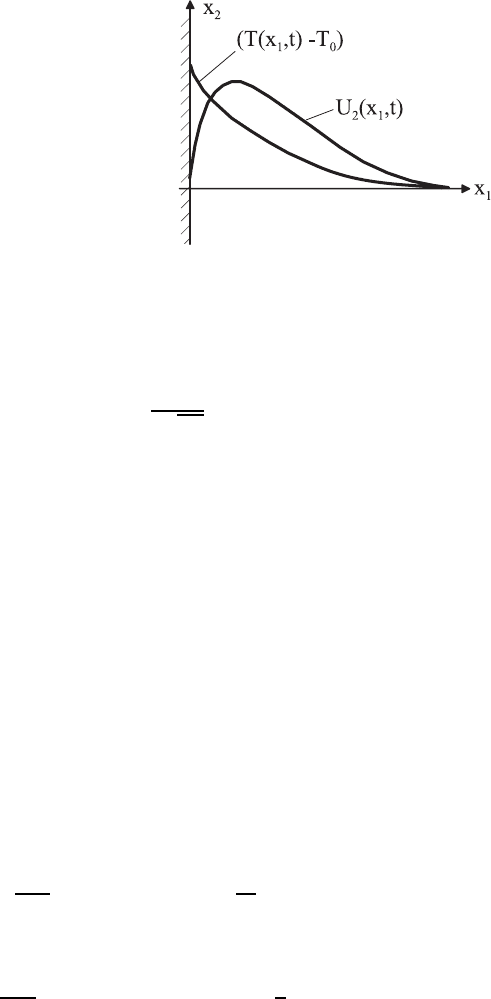
638 20 Fluid Flows with Heat Transfer
Fig. 20.6 Unsteady natural convection
flow at a flat vertical plate
The above flow problem has to be solved as a one-dimensional, unsteady
natural convection flow problem, namely as a similarity solution of the equa-
tion system (20.57) and (20.58). To derive the solution, we introduce the
similarity variable:
η =
x
1
2
√
ν
0
t
(20.59)
and for the dependent variables U
2
(x
1
,t)andT (x
1
,t)forx
1
≥ 0 the similarity
ansatz:
U
2
(x
1
,t)=[β
0
(T
W
− T
0
) gt] F (η) (20.60)
and
T (x
1
,t)=(T
W
− T
0
) G (η) . (20.61)
These ansatzes are introduced in this particular form with the aim of con-
serving the dimensionless forms of the differential equations describing the
problem and, moreover, to transfer the partial differential equations into
ordinary differential equations.
The above ansatzes (20.60) and (20.61) hold for Pr =1andaresolved
below for this special case. More general solutions for Pr =0weregiven
by Illingworth [20.1] and can be looked up there. The special case discussed
here suffices to introduce students of fluid mechanics to the field of natural
convection flows.
With the above similarity ansatz, one obtains for the derivative in the
differential equation for U
2
:
ρ
0
∂U
2
∂t
= ρ
0
β
0
(T
W
− T
0
) g
∂
∂t
[tF (η)] (20.62)
or the derivative executed with respect to t:
ρ
0
∂U
2
∂t
= ρ
0
β
0
(T
W
− T
0
) g
F −
1
2
ηF
. (20.63)
Similarly, for the first derivative with respect to x
1
:

20.4 Non-Stationary Free Convection Flow 639
µ
0
∂U
2
∂x
1
= µ
0
β
0
(T
W
− T
0
) gtF
1
2
√
ν
0
t
(20.64)
and thus for the second derivative:
µ
0
∂
2
U
2
∂x
1
2
= µ
0
β
0
(T
W
− T
0
) gtF
1
4ν
0
t
(20.65)
or in consideration of ν
0
=(µ
0
/ρ
0
) transcribed as:
µ
0
∂
2
U
2
∂x
1
2
= ρ
0
β
0
(T
W
− T
0
) g
1
4
F
. (20.66)
For the gravitation term in the U
2
differential equation, one obtains:
(ρ − ρ
0
)g = ρ
0
β
0
(T − Z
0
)g = ρ
0
β
0
(T
W
− T
0
)gG(η). (20.67)
Insertion of (20.63), (20.66) and (20.67) into the momentum equation to be
solved, yields the following ordinary differential equation for F (η):
F
+2ηF
− 4F +4G =0. (20.68)
For the derivatives in the energy equation in terms of time, one obtains:
ρ
0
c
0
∂T
∂t
= ρ
0
c
0
(T
w
− T
0
)
∂
∂t
[G(η)] (20.69)
and after carrying out the differentiation:
ρ
0
c
0
∂T
∂t
= ρ
0
c
0
(T
W
− T
0
)
η
2t
G
. (20.70)
Deriving the second derivative with respect to x
1
yields:
λ
0
∂
2
T
∂x
1
2
= G
λ
0
ρ
4µ
0
t
(T
W
− T
0
) (20.71)
and for Pr =1
λ
0
∂
2
T
∂x
1
2
= G
1
4t
ρ
0
c
0
(T
W
− T
0
). (20.72)
Insertion of (20.70) and (20.71) into the energy equation yields:
G
− 2ηG
=0. (20.73)
The boundary conditions for the solution of the above ordinary differential
equations (20.68) and (20.73) read:
x
1
=0:U
2
(0,t)=0 ; η =0:F (0) = 0
T (0,t)=T
W
; G(0) = 1
x
1
→∞: U
2
(∞,t)=0 ; η =1:F (1) = 0
T (∞,t)=T
0
; G(1) = 0
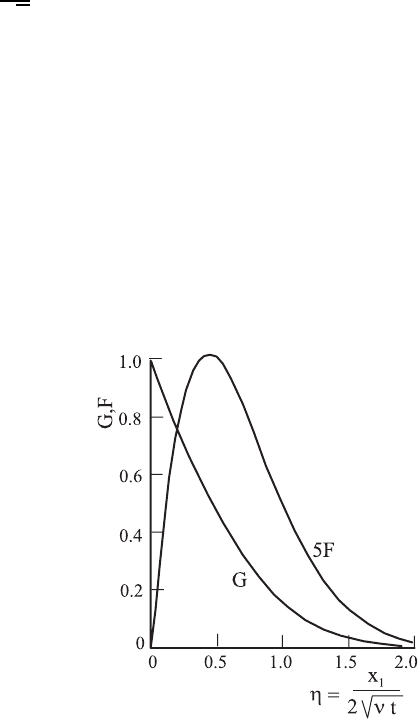
640 20 Fluid Flows with Heat Transfer
As a solution of the differential equation (20.73), one obtains:
G(η)=1− erf(η). (20.74)
The solution of the differential equation (20.68), with G(η) inserted, can be
obtained as a solution of the homogeneous differential equation for F (η):
F
+2ηF
− 4F = 0 (20.75)
and with the particular solution F (η)=erf(η) and adding the homogeneous
solution results in
F (η)=
2
√
π
η exp
!
−η
2
"
− 2η
2
erf(η). (20.76)
With this, the solutions for F and G, as shown in Fig. 20.7, can be determined
from (20.74) and (20.76). With a decrease in G with increase in η, a decrease
in temperature with increasing distance from the wall is indicated. The F (η)
distribution relates to the velocity distributions for the natural convection.
This convective flow forms due to the buoyancy forces induced by density
differences near the wall.
The parts of the similarity solutions of the equation system (20.57) and
(20.58) represented in Fig. 20.7 show, on the one hand, the normalized tem-
perature profile G(η) that develops due to the temperature diffusion from
Fig. 20.7 Solutions F (η)andG(η)for
the free convection flow along a plane
vertical plate

20.5 Plane-Plate Boundary Layer 641
the heated wall into the fluid. The figure shows, moreover, the standardized
velocity profile, which is caused by buoyancy and which is strongly influ-
enced by the molecule-dependent momentum loss to the wall. Because of the
assumed fully developed flow in the x
2
direction, for the temperature field
(20.61) and the velocity field (20.60) physically convincing solutions result
from the differential equations. Altogether the flow and temperature distri-
butions are understood as examples of many buoyancy flows that exist in
nature in a large variety. For a number of these flows, driven by temperature
fields, analytical solutions exist.
20.5 Plane-Plate Boundary Layer with Plate Heating
at Small Prandtl Numbers
In Chap. 16, the two-dimensional boundary-layer equations were derived from
the general Navier–Stokes equations according to a procedure suggested by
Prandtl. On extending these derivations to boundary-layer flows with heat
transfer, one obtains on the following assumptions:
x
1
= flow direction; x
3
= direction with ∂/∂x
3
(···)=0
the following equations for x
1
= x, x
2
= y, U
1
= U, U
2
= V :
Stationary Compressible Flows (Boundary-Layer Equations)
∂
∂x
(ρU)+
∂
∂x
(ρV )=0, (20.77)
ρ
U
∂U
∂x
+ V
∂U
∂y
= −
dP
dx
+
∂
∂y
µ
∂U
∂y
+ ρg
x
β (T − T
∞
) , (20.78)
ρc
p
U
∂T
∂x
+ V
∂T
∂y
= U
dP
dx
+ λ
∂
2
T
∂y
2
+ µ
∂U
∂y
2
, (20.79)
ρ = constant or
P
ρ
= RT and µ = µ(T ),λ(T ),c
p
(T ). (20.80)
Hence, there are four differential equations for U, V , P , ρ and T ,whichcan
be solved with the boundary conditions defining the respective problem. For
incompressible flows, we obtain the following:
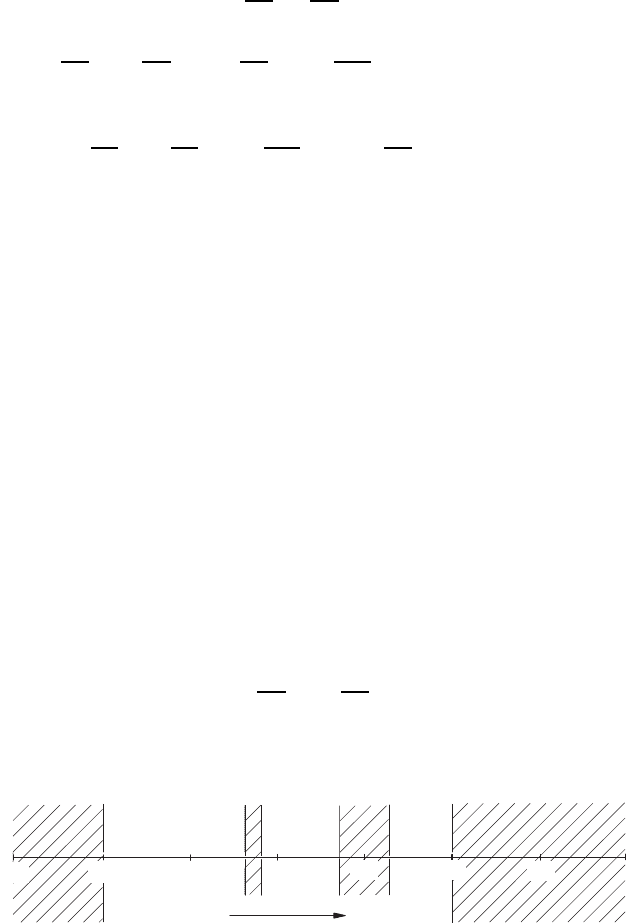
642 20 Fluid Flows with Heat Transfer
Stationary Incompressible Flows (Boundary-Layer Equations)
∂U
∂x
+
∂V
∂y
=0, (20.81)
ρ
∞
U
∂U
∂x
+ V
∂U
∂y
= −
dP
dx
+ µ
∞
∂
2
U
∂y
2
− ρ
∞
g
x
β
∞
(T − T
∞
) , (20.82)
ρ
∞
c
p∞
U
∂T
∂x
+ V
∂T
∂y
= λ
∂
2
T
∂y
2
+ µ
∞
∂U
∂y
2
+ ρ
∞
g
x
β
∞
(T − T
∞
) .
(20.83)
This system of partial differential equations can be solved for ρ = ρ
∞
=
constant, λ = λ
∞
= constant, c
p
= c
p∞
= constant and µ = µ
∞
= constant
for plane-plate boundary-layer flows by including the boundary conditions
that characterize the flow and heat-transfer problem, in order to compute U,
V and T . The externally imposed pressure gradient (dP/dx) can often be
assumed to be given for this kind of flow.
In order to integrate the equations, it is recommended also to include in
the considerations the influence of the Prandtl number on the solution. Here,
it has to be taken into consideration that the Prandtl numbers of the fluids
considered in this book, are able to cover the wide range that is indicated in
Fig. 20.8.
For boundary-layer flows with very small Prandtl number, i.e. boundary
layers of melted metals, thermal boundary layers result, which are many
times thicker than the fluid boundary layers (see Fig. 20.9). It is therefore
understandable that it is recommended, for small Prandtl numbers, to treat
boundary-layer flows with heat transfer, such that the fluid boundary layer
is entirely neglected. From the continuity equation (20.81), it follows that
the gradients of V in y direction and U in x direction are connected in the
following way:
∂V
∂y
= −
dU
dx
(20.84)
Prandtl number
Pr
Gases Water
Viscous oils
Liquid metals
10
2
10
3
-
10
2
-
10
1
-
10
0
-
10
1
10
3
Fig. 20.8 Domains of Prandtl numbers for different fluids (fluids and gases)
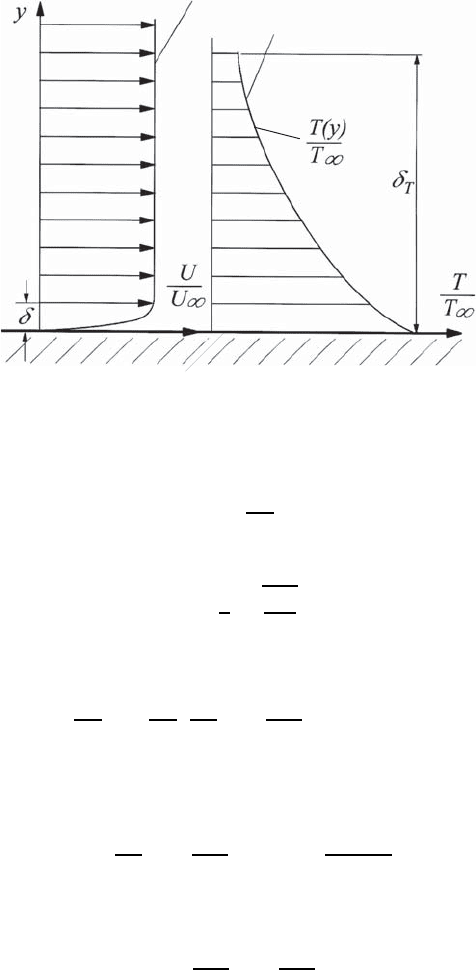
20.5 Plane-Plate Boundary Layer 643
Velocity distribution
Temperature distribution
Plate
Fig. 20.9 Thermal boundary layer and thermal boundary layer for small Prandtl
numbers
and thus
V = −
dU
dx
y. (20.85)
For the analytical considerations to be carried out, the similarity variable:
η =
1
2
y
0
U
∞
ax
(20.86)
is introduced. From the energy equation, one obtains:
U
x
∂T
∂x
− y
dU
dx
∂T
∂y
= a
∂
2
T
∂y
2
(Pr << 1) . (20.87)
For T = T
W
for y =0andT = T
∞
for y →∞(and this for all x positions),
one obtains for a constant external flow, i.e. U(x)=U
∞
= constant,
U
∞
∂T
∂x
= a
∂
2
T
∂y
2
with a =
λ
∞
ρ
∞
c
p,∞
. (20.88)
For the standardized temperature T
∗
=(T − T
∞
)/∆T
w
with ∆T
w
=(T
w
−
T
∞
), one obtains:
U
∞
∂T
∗
∂x
= a
∂T
∗
∂y
(20.89)
and with the similarity ansatz:
T
∗
= f(η) (20.90)
